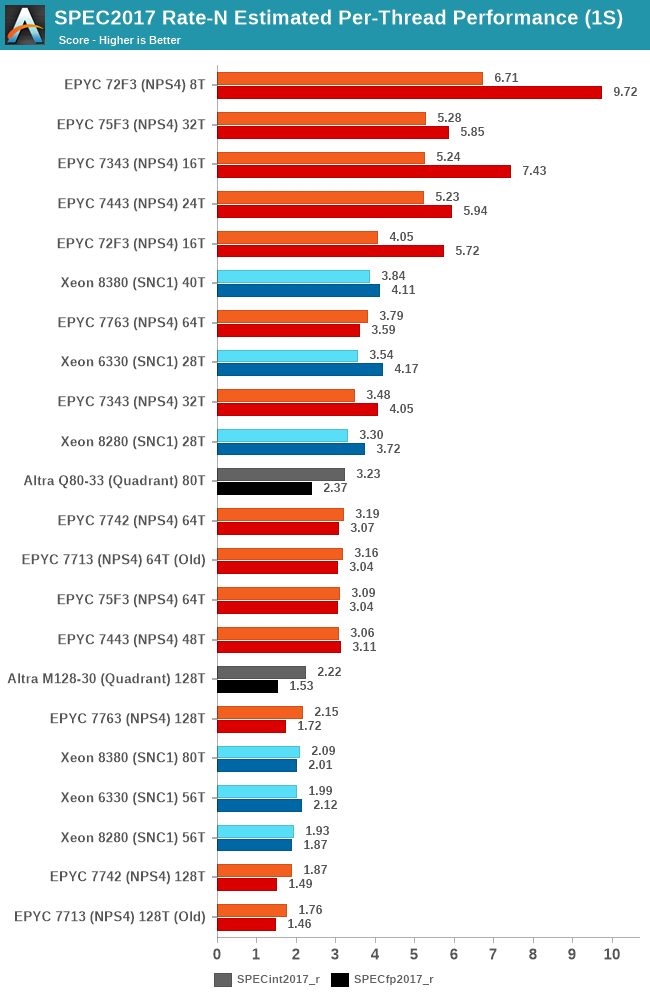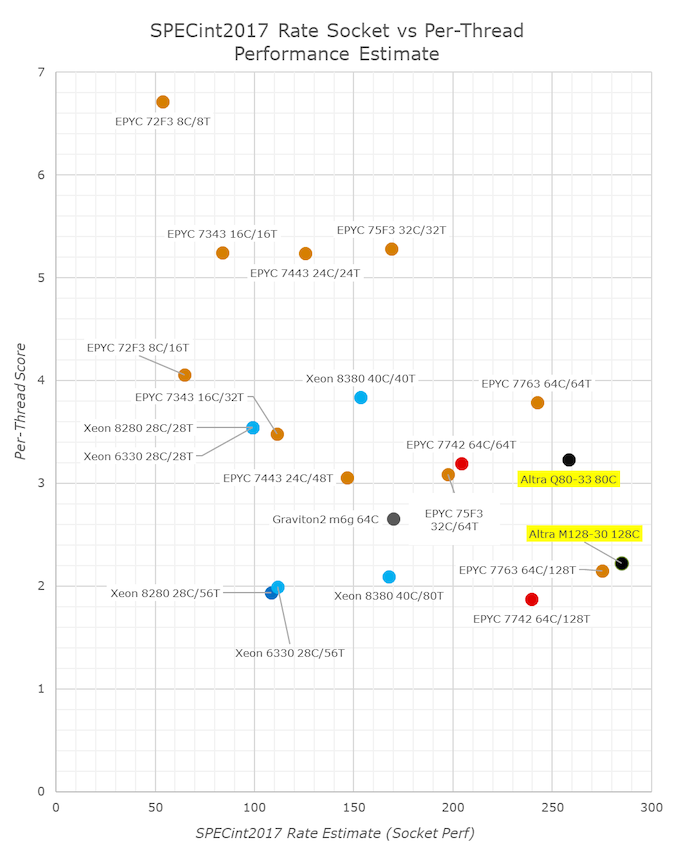The Ampere Altra Max Review: Pushing it to 128 Cores per Socket
by Andrei Frumusanu on October 7, 2021 8:00 AM EST- Posted in
- Servers
- Arm
- Neoverse N1
- Ampere
- Altra Max
SPEC - Per-Core Performance under Load
A metric that is actually more interesting than isolated single-thread performance, is actually per-thread performance in a fully loaded system. This actually is a measurement and benchmark figure that would greatly interest enterprises and customers which are running software or workloads that are possibly licensed on a per-core basis, or simply workloads that require a certain level of per-thread service level agreement in terms of performance.
The Altra Max here is inevitably expected to post worse metrics than the Altra – first of all due to the 10% lower core frequencies, and second of all due to lower shared resources that need to be shared amongst more cores.

As expected, taking view of the aggregate socket performance figures here, the M128-80 doesn’t fare well here in the metric, as it takes the much controversial “flock of chickens” approach to core performance. It’s also dragged down by the score regressions in the memory bound workload in SPEC.
In terms of total throughput vs per-thread performance, the M128-30 barely differs to the EPYC 7763 with SMT and half the physical cores.
Again, I have to reiterate that these figures are all very much not in favour of the workloads that the Altra Max was designed for – cloud and hyperscaler workloads, which don’t tend to have the same harsher memory demands as some of the workloads in the SPEC suite. However, extracting those workloads in a different subset would also be a questionable practise and actually frowned upon.
The Altra Max here really does need to have huge footnotes in the way that it presents itself.











60 Comments
View All Comments
Wilco1 - Sunday, October 10, 2021 - link
> You need only note the cases where Max significantly underperforms, relative to its 80-core sibling, to see where the cache reduction is likely an issue.There are regressions in 4 of the 10 integer benchmarks - only mcf is significant. However if you look closely, Altra Max still beats/equals the 8380 in 3 out of those 4. Clearly a 40MB L3 is not large enough for these benchmarks, so would you also call that a "major liability"? EPYC beats all by a huge margin in these 4, so clearly 256MB L3 works well, but it's also way too expensive for a monolithic die.
> The reason why there are so many different benchmarks is that you can't just seize on the aggregate numbers to tell the whole story.
No. The aggregate result averages out the extremes and is a better prediction for average performance. For example Altra Max is slower than Altra on gcc_r and far behind EPYC. However in LLVM compilation Altra Max beats Altra by ~20% and is pretty much equal to the 7763. So in real world tests EPYC's huge caches don't help nearly as much as the gcc_r subtest suggests.
mode_13h - Sunday, October 10, 2021 - link
> There are regressions in 4 of the 10 integer benchmarks - only mcf is significant.When you have 45% more core x GHz, *any* regression is significant! By that token, we should also be marking the xz test as underperforming, since it's only a ~20% improvement.
It's also convenient to seize on specint, when it suffers regressions on 7 of the 12 specfp tests.
> Altra Max still beats/equals the 8380 in 3 out of those 4.
> Clearly a 40MB L3 is not large enough for these benchmarks,
> so would you also call that a "major liability"?
This seems like a rather disingenuous point. To say anything about the 8380's cache, we'd need to see a comparison against other Ice Lake CPUs with a different core-to-cache ratio.
> No. The aggregate result averages out the extremes and is a better
> prediction for average performance.
It's a flawed inference to conclude that "the average workload" will match an unweighted average of a set of intentionally disparate workloads.
Furthermore, people less & less buy hardware for "the average workload".
> in LLVM compilation Altra Max beats Altra by ~20% and is pretty much equal to the 7763.
You can't just cherry-pick the best results of each memory configuration. If you're going to deal in aggregates, then you need to aggregate the results per-configuration.
> So in real world tests EPYC's huge caches don't help nearly as much as the gcc_r subtest suggests.
As a matter of fact, the monolithic vs. quadrant results would argue the opposite, in your chosen example of LLVM. Furthermore, what qualifies LLVM compilation as more "real world" than the gcc test?
schujj07 - Monday, October 11, 2021 - link
"The Altra Max wins the more useful critical-jOPS benchmark by over 30%"What are you talking about? In both critical-jOPS & max-jOPS the 2s 7763 is on the top of the chart. We cannot try to extrapolate possible performance on the Altra Max due to "Unfortunately, trading in one issue with another, we ran into other issues on the 2-socket test scenario where the test ran into issues at large thread counts. The 2S Q80-33 figures here only stresses 130 cores, while I wasn’t able at all to get 2S M128-30 figures at reasonable core counts, so I completely omitted results here."
Per-core performance matters a lot. There are A LOT of programs, especially databases, that are licensed on a per core metric. This means I need 8 cores of Altra Max to equal the performance I get from an Epyc 4c that will kill my licensing cost. Those added cores could easily double the license cost and those license are often times MUCH more expensive than the server itself. It is obvious you don't work in industry as this is common knowledge.
Overall the Altra Max is interesting but nothing more than that. It won't be a player in industry until the per core performance is at least double what it currently is and there is enterprise software able to take advantage of it. Basically Altra Max is like IBM Power and that is niche at best.
Wilco1 - Tuesday, October 12, 2021 - link
Altra Max is still at the top for 1S critical-jOPS - that's not invalidated by missing 2S results.If you worked in the industry, you would know that per-core licenses have a multiplier based on CPU type to level out performance differences. In cases where per-core performance really matters and you completely disable SMT (for example for high-frequency trading), you would not consider these many-core servers at all but get 8 or 16 core CPUs with significantly higher bandwidth, cache and power per core.
It seems you misunderstand the target market completely. You probably also call Graviton 2 a niche eventhough it is already a significant percentage of AWS and growing fast. And that with just 64 cores and far lower per-core performance than Altra...
schujj07 - Tuesday, October 12, 2021 - link
How about we do some math instead. Compared to the 1S 80 core, the 1S Max gets 42% better performance, THP disabled, or 30% better performance THP enabled for 60% more cores in your beloved critical-jOPS. Compare that to the Epyc 7763 which gets 105% better THP disabled and 102% THP enabled. Even the older 80C only adds 62% despite doubling its cores. Based on that alone best case scenario is the 2S Altra Max ties the Epyc 2S in critical-jOPS. Sure it is beating the 1S 7763 but it barely beats the 2S 7443 a 24c/48t CPU.I do work in industry as a VMware Admin. Unless you are running Oracle, most of these will be run on systems up to 32c/64t to max out your VMware license. If you have specific needs you can get the higher frequency parts that also are up to 32c AMD or 28c Intel. The difference in costs for Windows DataCenter for the core additional core licenses is saved by reducing the number of physical hosts. What software has "per-core licenses have a multiplier based on CPU type to level out performance differences?" That sounds like they are going to charge your X for Xeon Scalable Gen 1 but Y for Gen 2 and Z for AMD. That doesn't happen. MS SQL Server charges per core with a base license of 4 cores. Now if I need 8 cores on the Altra Max to equal the performance of an Epyc at 4 cores I have doubled my license cost.
Overall ARM with under 10% total market share IS a niche player. They need to get to the same per core performance & have software available for it to be an actual alternative. Until that happens companies will play around with it but nothing serious in the data center environment.
mode_13h - Tuesday, October 12, 2021 - link
> You probably also call Graviton 2 a nicheDon't put words in people's mouths. If you want to know whether @schujj07 considers it a niche, you can certainly ask.
Kangal - Thursday, October 7, 2021 - link
This is basically a 3GHz Cortex-A76 (Neoverse N1), running in a 128-core tandem, and built with a more efficient/expensive Monolithic Socket based on TSMC's 7nm node. Sounds neat.I enjoyed seeing the older generation which was basically a 2GHz Cortex-A73, running in 64-core tandem, and built on TSMC's 16nm node. Was quiet value-for-money, at least in its time.
Seems like this new version is giving Intel's Core-i, decent competition in the single-threaded work. Since Intel is having some issues with their own node, and can't clock too high. Whilst AMD has a clear advantage here. When it comes to total/multi-threaded performance, ARM wins through sheer grunt of all those extra cores. Overall, it is a competitive choice for today and the next few years.
What will be interesting is when they bump it up to the Cortex-A78 (Neoverse V1) and use something like TSMC's 5nm node which should bring it to full-parity on the single-threaded performance against Intel. Or to the next best thing, ARM v9, using the Cortex-X2 (Neoverse N2) on the same TSMC 5nm node. But I share my previous concerns that the first-generation of (USA) ARM v9 is going to be quiet disappointing, but I'm optimistic about the (European) second-generation. I think then we should see more tangible benefits, when combined with the TSMC 3nm node, which should bring it on parity to AMD's cores on the single-threaded characteristic. Exciting times ahead. And yes, I know I am over-simplifying things here.
SarahKerrigan - Thursday, October 7, 2021 - link
Previous Ampere parts weren't 64-core, 2GHz, or Cortex-A73. They were a custom (and bad) core, 32 per socket, at 3.3GHz.Neoverse V1 is based on the Cortex-X1, not the Cortex-A78. Neoverse N2 is based on the Cortex-A710, not the Cortex-X2.
Kangal - Friday, October 8, 2021 - link
Sorry, by "older generation" I was talking about the Amazon Graviton one, not the previous Ampere Version.The proper upgrade from the Cortex-A76 is the Cortex-A78.
The Cortex-A78 is the base micro-architecture, with the Cortex-X1 being a slightly modified derivative of it, and the Neoverse-V1 is a further slightly modified version of that. That's why I worded it in that way. Whilst ARM claims a divergence between the Cortex-A710, Cortex-X2, and Neoverse-N2... I think we will end up seeing them much more closer in-common than different.
SarahKerrigan - Friday, October 8, 2021 - link
The Graviton1 was 16 Cortex-A72 at 2.3GHz.